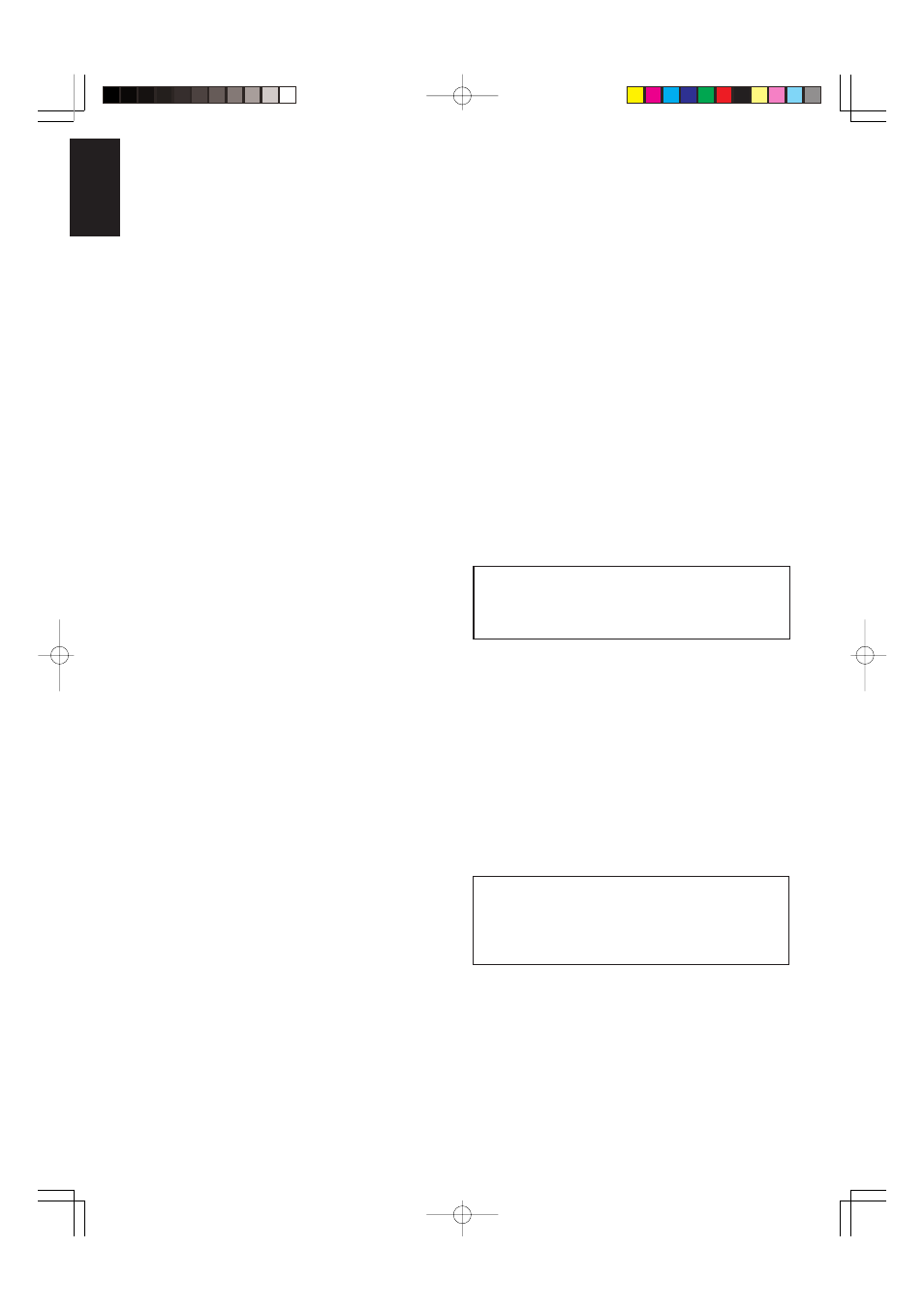Marantz PM7200 User Manual
Page 7

ENGLISH
FRAN
Ç
AIS
DEUTSCH
NEDERLANDS
ESP
A
Ñ
OL
IT
ALIANO
POR
TUGU
Ê
S
SVENSKA
D
ANSK
2
!3
CLASS A INDICATOR
This indicator lights when the amplifier is in the Class A operation
mode. See “@3 Class A Switch” for details.
!4
TAPE,CD-R/MD SELECTOR BUTTONS
Press one of these switches to select a connected tape deck or
CD-R/MD for monitoring or playback. Pressing a TAPE,CD-R/MD
SELECTOR button causes the indicator above it to light.
Pressing a TAPE,CD-R/MD SELECTOR button while the amplifier
is in the Standby Mode automatically turns power back on.
!5
INPUT SELECTOR
Use this selector to specify PHONO, CD, TUNER, AUX 1, or AUX 2
as the program source for recording or play. Selecting a program
source causes the indicator above it to light.
Changing the INPUT SELECTOR setting while the amplifier is in
the Standby Mode automatically turns power back on.
!6
REMOTE SENSOR
The remote sensor receive infrared commands from the remote con-
trol unit. Note that the remote control unit must be pointed directly
at the remote sensor for proper operation.
!7
VOLUME CONTROL
Rotate this knob clockwise to increase volume, and counter-clock-
wise to decrease volume.
!8
MUTING INDICATOR
This indicator lights when muting is activated by pressing the remote
control unit’s MUTE button.
IMPORTANT:
Be sure to double check the VOLUME control setting before press
ing the remote control unit’s MUTE button to cancel muting.
Restoring audio output while the VOLUME control setting is too
high can damage your speakers.
!9
BALANCE CONTROL
Rotate this knob to shift the balance of stereo output left and right.
Note that turning the BALANCE control all the way in either direction
causes output from the other side to be eliminated entirely.
@0
RECORD (REC) SELECTOR SWITCH
Use this switch to select recording between the tape deck and CD-
R/MD or recording of the signal selected by the INPUT SELECTOR
SWITCH and out put from the REC OUT jacks.
See the note under “Tape Deck, CD-R/MD Operation” on page 4 for
full details about settings.
@1
SOURCE DIRECT SWITCH
Press this switch to turn SOURCE DIRECT on (depressed) and off
(raised).
When SOURCE DIRECT is turned on, the audio signal path is as
short and direct as possible in order to enjoy high-quality sources
under the best conditions possible.
NOTE:
Tape and CD-R/MD playback and recording are not possible when
the SOURCE DIRECT switch is on. The TONE and BALANCE
controls are also disabled. Any graphic equalizer or other such
component that is connected to the PROCESSOR IN/OUT jacks
will not have any effect. In order to use any of these components
or controls, it is necessary to turn the SOURCE DIRECT switch off.
@2
BASS AND TREBLE TONE CONTROLS
Use these controls to control the levels of their corresponding fre-
quency bands. TREBLE adjusts the high frequency band, while
BASS adjusts the low frequency band. Rotating a control towards
(+) enhance the frequency band, while rotating towards (–)
attenuates the frequency band.
CONTROLS, CONNECTORS,
AND INDICATORS
(Figure 2)
q
REMOTE CONTROL BUS TERMINALS (REMOTE
CONT. BUS)
These terminals can used to connect other audio equipment that is
equipped with a remote control bus terminal. Connection requires a
special cable. The bus OUT terminal sends signal to the connected
equipment, while the bus IN terminals receive signals.
w
AUX1/AUX2 INPUT JACKS
These auxiliary input jacks can be used to connect the audio output
of a TV multiplex/stereo audio tuner, VCR, laserdisc system, or other
AV component audio output.
e
TUNER INPUT JACKS
Connect these jacks to the output jacks of your tuner.
r
CD INPUT JACKS
Connect these jacks to the output jacks of your compact disc player.
t
PHONO INPUT JACKS
Connect these jacks to the output jacks of your turntable. These
input jacks are exclusive for a turntable equipped with MM (Moving
Magnet) cartridge.
y
TAPE, CD-R/MD IN/OUT JACKS
Connect these jacks to the play (output) and record (input) jacks of
your recorders. Up to two decks can be connected.
u
PROCESSOR IN/OUT JACKS
Use these jacks to connect a graphic equalizer or other analog audio
processor. When not used, leave these jacks connected with the
supplied connecting pins.
i
GROUND TERMINAL
If your turntable has a grounding wire, connect it to this terminal.
o
SPEAKER SYSTEMS
Connect your speaker system(s) to these terminals. There are two
sets of terminals, so you can connect either one or two speaker
systems.
!0
AC OUTLETS (SWITCHED)
Connect the power cord of another piece of equipment (VCR, tuner,
CD) when you want the power of the connected equipment auto-
matically turned on whenever you turn on this amplifier. For this to
work correctly, the power switch of the connected equipment must
be left on. Normally, the audio output of the connected equipment
is also connected to this amplifier. Note that the total power con-
sumption of the connected all equipment must not exceed 120W.
!1
POWER CORD
Connect the power cord to a standard household power outlet.
!2
POWER SWITCH
Press this switch to turn power on (depressed) and off (raised). Note
that the power of any equipment connected to the switched AC outlet
on the rear panel (see !0 above) is also turned on and off by operat-
ing this switch.
Turning on the power causes the POWER indicator to light, and the
POWER indicator goes out when power is turned off.
While the POWER switch is in the ON position (depressed), you
can put use the remote control unit’s SYSTEM POWER ON and
OFF button to switch the amplifier between standby (indicated when
the @6 STANDBY indicator is lit) and power on.
PM7200U(ENG)
03.12.17, 11:18 AM
Page 2
Adobe PageMaker 6.5J/PPC
